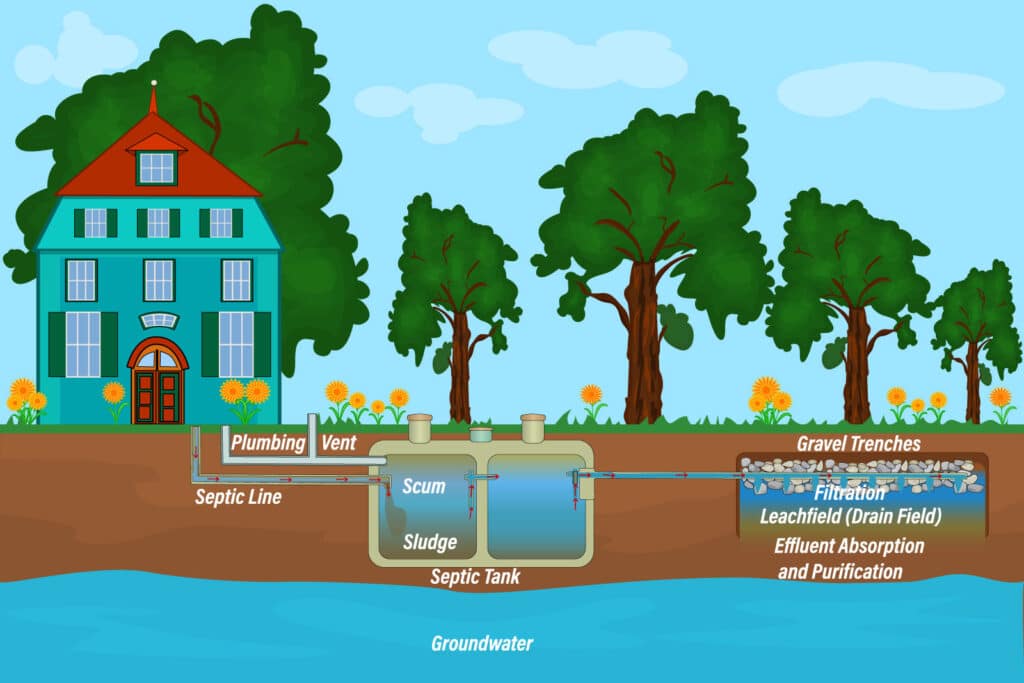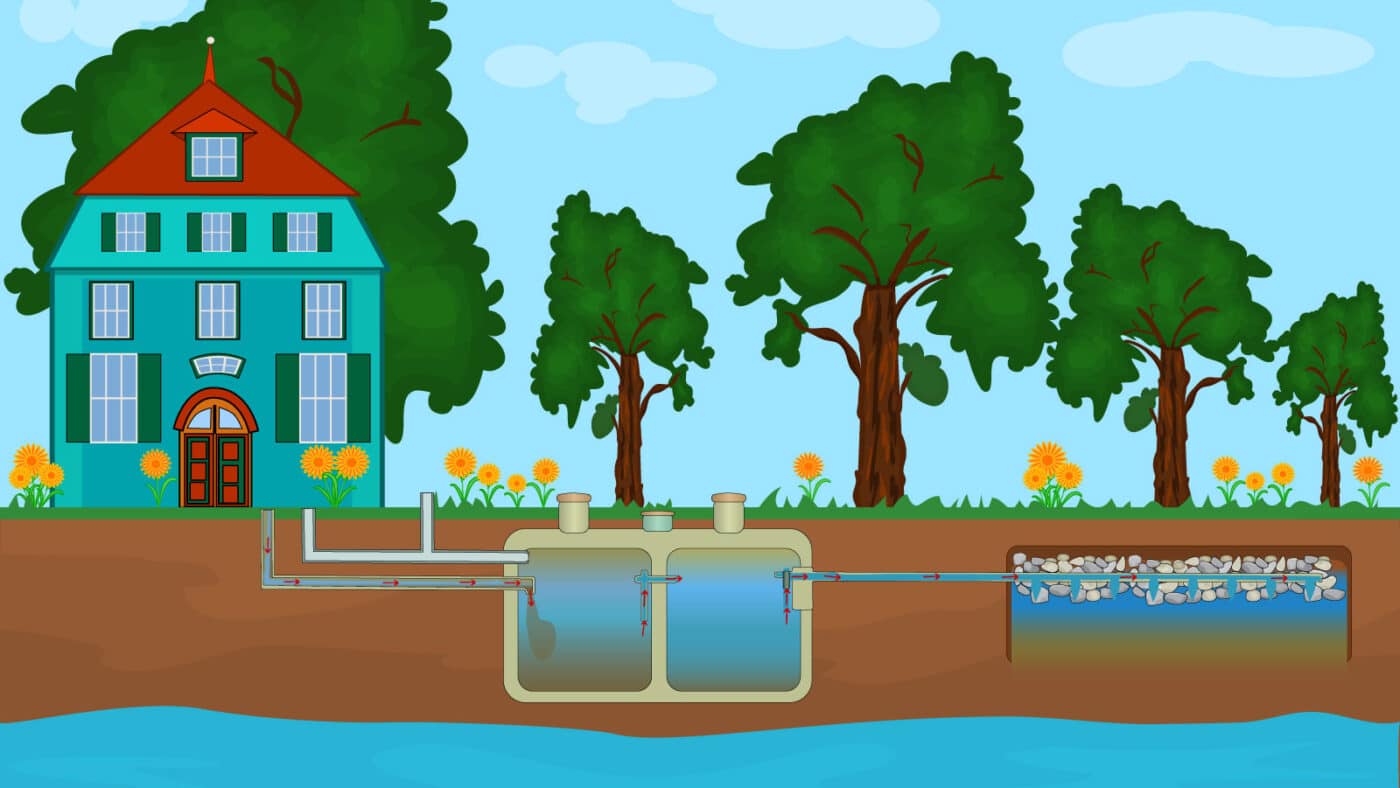On-site wastewater disposal systems (septic systems) can lead to varying degrees of damage to a property and can be a costly expense if they fail. Understanding the basic function of a septic system, its components, and common signs of failures is important to evaluating and mitigating damages from septic system failures. However, just because the system is experiencing issues does not mean that a full replacement is needed.
Septic System Basics
Septic systems can come in various shapes, sizes, configurations, and technologies. However, in their most basic form, they involve two main components:
- A septic tank to separate and collect solids.
- A soil absorption system (aka leach field) for filtering and treating wastewater prior to leaching clean water back into ground.
The septic tank serves two main functions:
- It is the initial collection point of the wastewater from the house (or building).
- It slows and retains the wastewater through a process that separates the liquid from the solids and allows solids to settle to the bottom and the liquid to discharge to the leach field. The retained solids experience anerobic decomposition within the septic tank.
The leach field receives liquid waste containing toxic organics and pathogens from the septic tank and also performs two main functions:
- Filters and treats the wastewater through a filter bed of select materials.
- The leach field hosts a layer of bacteria and other organisms that consume the toxic organics and pathogens in the wastewater prior to releasing clean water back into the ground

Common Reasons That Septic Systems Fail
The most common cause of septic system failures is inadequate maintenance and/or improper care. Specifically, not pumping out the solids in a septic tank regularly is the most common failure mode. Septic tanks should be pumped every 3-5 years depending on occupancy and use. Another common failure mode is from flushing or pouring chemicals down the interior plumbing fixtures. Large quantities of harsh chemicals can kill the bacteria in the leach field effectively eliminating the essential components to treat and clean the wastewater. Additionally, harsh chemicals can cause an impermeable mat to form causing a backup of wastewater into the tank (and eventually the house), and/or it can cause ponding in the yard above the leach field. Similar to flushing chemicals, another failure mode involves flushing solid, non-septic-safe items down the plumbing fixtures such as paper towels. This can cause physical clogs and backups in the pipes or at the tank.
Typical Signs of Failure or Issues
Wastewater backup into the house
This sign of failure is easy to identify and for obvious reasons is very unpleasant. A wastewater backup prevents discharge from the house and results in wastewater backflowing out of household fixtures such as a toilet or sink. Most often this occurs at the lower levels of the house.
There are several things that could cause wastewater to back up into the house and could occur anywhere in the entire septic system from the plumbing leaving the house to the leach field. The most common cause is due to a clog in the pipe between the house and the septic tank or a clog in the septic tank itself. A clog in the pipe can be mitigated by a plumber with simple tools and knowledge. Somewhat recently, septic installers and septic pumping companies have begun installing an effluent filter on the septic tank outlet that prevents solids from entering the leach field. If this filter is clogged from lack of pumping or flushing non-septic safe items, it will cause backup into the house. Next time you have your septic tank pump, ask the pumping company if your tank has an effluent filter. If it does not, consider asking for them to install one.
As mentioned above, backup into the house can also be evidence of a catastrophic failure of the leach field. However, when a failure of the leach field occurs, there are often more signs than just septic backup into the house.
Green spots in the lawn
Contrasting areas of bright green in the lawn above septic system components can be a sign the system is not functioning properly.
In general, a bright green area in the lawn is caused by the septic system malfunctioning by inappropriately discharging wastewater to the surface of the yard and simultaneously fertilizing and watering the area. The underlying issues with the septic system that could be causing the malfunction can include a crack or hole in the septic tank causing an unintended leak, or a backup or failure of the leach field preventing wastewater from properly draining into the ground. Occasionally, excessive water discharging to the surface causes the ground to be continuously mushy and wet and is likely a sign the system is at the end of its useful life. Whether a leaky septic tank or failed leach field, the system is not functioning properly if it is discharging wastewater to the surface and can be causing hazardous and unsafe conditions.
Wastewater smell in the house or yard
This sign of failure can be a bit more discreet and may be hard to identify. The scent may only be detectable at certain times or when the wind is blowing in a certain direction.
A wastewater smell is typically evidence of a small issue such as a loose cover on the septic tank. It is also commonly caused by the plumbing vent on the roof of the house. Homeowners often notice the smell when working in parts of the yard that they do not use on a daily basis (e.g. garden or gazebo). The wind can cause the smell to travel downwards to a particular area of the yard. Filters can be purchased for installation over the vent if desired. Although scent can be evidence of a more severe type of failure, in those cases it is often accompanied by other signs of failure such as those described previously.
How Can VERTEX Help?
Septic System Issues can present themselves in a variety of ways. VERTX’s team of forensic engineers has expertise in septic system design, installation, and failure analysis. We also can inspect and recommend repairs for moisture intrusion, mold remediation, and wood rot caused by moisture exposure.
To learn more about VERTEX’s Environmental Consulting and Remediation services or to speak with an Environmental Expert, call 888.298.5162 or submit an inquiry.




